Do you have a question about the Craftsman 358.352161 and is the answer not in the manual?
Identifies the specific model number and lists the main sections covered in the manual.
Provides phone numbers and operating hours for customer assistance and repair services.
Highlights critical safety instructions to prevent serious injury from improper use.
Details essential protective gear required for safe chain saw operation, including head, eye, hearing, and body protection.
Emphasizes understanding the saw and planning operations for safe execution and hazard avoidance.
Outlines procedures for safe mixing, pouring, and storage of fuel to prevent fire hazards.
Warns about potential health effects from prolonged vibration exposure and recommends seeking medical attention if symptoms occur.
Specifies requirements for professional servicing and checks to ensure the saw is in safe operating condition.
Provides guidelines for safely transporting and storing the chain saw and its fuel.
Explains kickback, a dangerous reaction, and details precautions to avoid it.
Describes features like reduced-kickback guide bars and low-kickback chains designed to minimize kickback risk.
Offers advice on proper grip, stance, and body positioning to maintain control of the saw.
Explains pinch-kickback and pull-in, reactive forces that can cause loss of control.
Outlines user duties for maintaining the saw, including safety rules and regular care.
Details the one-year warranty, exclusions, and how to obtain warranty service.
Provides important notices regarding muffler requirements and commercial logging safety regulations.
Lists and illustrates various accessories and essential components for chainsaw performance and upkeep.
Lists essential tools needed for performing maintenance and repairs on the chain saw.
Provides step-by-step instructions for safely removing the chain saw and its components from the packaging.
Identifies and explains the function of various parts and controls of the chain saw, illustrated with a diagram.
Explains the automatic chain oiler, its function, and the importance of filling the oil tank.
Details the throttle trigger, lockout, and fast idle lock mechanism for controlling engine speed.
Describes the choke's function in starting a cold engine and its three positions.
Provides recommendations for bar oil and explains its automatic lubrication function.
Details the correct unleaded gasoline and 40:1 oil mixture, including warnings about gasohol.
Explains the use of fuel stabilizer and the specific type of 2-cycle oil required for the engine.
Provides step-by-step instructions for starting the engine when it is cold or has run out of fuel.
Outlines the procedure for starting the engine when it is already warm.
Explains how to clear a flooded engine and troubleshooting steps for starting failures.
Details critical safety procedures for preventing injury and damage, particularly when the saw is pinched or experiences reactive forces.
Explains how to avoid pinch-kickback and pull-in by being aware of cutting situations and using proper techniques.
Explains how to assess factors like wind, lean, and shape to predict the natural direction a tree will fall.
Provides detailed steps for making the notch and felling cut, including the use of wedges.
Offers advice on preparing the work area, clearing obstacles, and recognizing signs that a tree is ready to fall.
Illustrates and warns against cutting in unsafe positions relative to wind, lean, and tree balance.
Advises against cutting near hazards and in adverse weather, and highlights risks from rotted trunks or falling branches.
Explains overcutting and undercutting techniques for cutting logs, including ground bucking and using supports.
Provides advice on safe bucking practices, such as cutting one log at a time and maintaining secure footing.
Details how to remove branches from a felled tree, working from base to top and supporting the tree.
Explains techniques for pruning branches from a standing tree, including small and large branches.
Highlights safety precautions, including avoiding cutting above shoulder height and guarding against kickback.
Provides guidance on unit maintenance, warranty adherence, and essential safety precautions before performing work.
Lists critical checks for damaged parts, loose fasteners, and chain tension before operating the saw.
Explains how to check and adjust the chain tension to ensure proper operation and safety.
Provides detailed instructions and safety warnings for sharpening the chain cutters and depth gauges.
Defines key terms and identifies parts related to the chain, pitch, gauge, and cutters.
Identifies signs that indicate the guide bar needs maintenance, such as skewed cutting or poor oil supply.
Details steps for cleaning the guide bar groove, lubrication hole, and removing burrs.
Explains the importance of a clean air filter and how to clean or replace it for optimal engine performance.
Details inspection and cleaning of the muffler and spark arrestor screen to prevent fire hazards and maintain performance.
Recommends yearly replacement of the spark plug for easier starting and better engine running.
Provides step-by-step instructions for safely removing and replacing the fuel filter, including necessary precautions.
Details how to adjust chain tension, check for sag, and tighten components correctly.
Explains how to check if the chain is too tight or too loose and the steps to correct it.
Provides detailed instructions and safety warnings for replacing the starter rope, emphasizing spring tension.
Provides initial settings and crucial warnings for adjusting the carburetor to prevent engine damage.
Details how to adjust the low speed mixture for optimal engine performance at low RPMs.
Explains how to adjust the high speed mixture for optimal engine performance at full throttle.
Describes how to check and fine-tune the engine's acceleration response after mixture adjustments.
Details how to prepare the fuel system, including draining fuel and using stabilizer, to prevent gumming and damage.
Outlines steps to protect the internal engine components from corrosion during long-term storage.
Provides advice on storing the unit safely, out of reach of children, and protecting it from dust and moisture.
Addresses issues like engine not starting, rough idling, lack of power, and excessive smoking with causes and corrections.
Covers problems such as chain movement, rough cutting, chain stopping, and lubrication failures with solutions.
Illustrates major chainsaw components with reference numbers and a comprehensive list of part numbers and descriptions.
Lists specific parts related to the engine, air filter, muffler, and ignition system with part numbers.
Identifies carburetor parts, limiter caps, and the carburetor repair kit with corresponding part numbers.
Provides contact numbers for ordering parts and obtaining repair service for the chain saw.
Lists customer assistance phone numbers and operational hours for support.
Identifies the specific model number and lists the main sections covered in the manual.
Provides phone numbers and operating hours for customer assistance and repair services.
Highlights critical safety instructions to prevent serious injury from improper use.
Details essential protective gear required for safe chain saw operation, including head, eye, hearing, and body protection.
Emphasizes understanding the saw and planning operations for safe execution and hazard avoidance.
Outlines procedures for safe mixing, pouring, and storage of fuel to prevent fire hazards.
Warns about potential health effects from prolonged vibration exposure and recommends seeking medical attention if symptoms occur.
Specifies requirements for professional servicing and checks to ensure the saw is in safe operating condition.
Provides guidelines for safely transporting and storing the chain saw and its fuel.
Explains kickback, a dangerous reaction, and details precautions to avoid it.
Describes features like reduced-kickback guide bars and low-kickback chains designed to minimize kickback risk.
Offers advice on proper grip, stance, and body positioning to maintain control of the saw.
Explains pinch-kickback and pull-in, reactive forces that can cause loss of control.
Outlines user duties for maintaining the saw, including safety rules and regular care.
Details the one-year warranty, exclusions, and how to obtain warranty service.
Provides important notices regarding muffler requirements and commercial logging safety regulations.
Lists and illustrates various accessories and essential components for chainsaw performance and upkeep.
Lists essential tools needed for performing maintenance and repairs on the chain saw.
Provides step-by-step instructions for safely removing the chain saw and its components from the packaging.
Identifies and explains the function of various parts and controls of the chain saw, illustrated with a diagram.
Explains the automatic chain oiler, its function, and the importance of filling the oil tank.
Details the throttle trigger, lockout, and fast idle lock mechanism for controlling engine speed.
Describes the choke's function in starting a cold engine and its three positions.
Provides recommendations for bar oil and explains its automatic lubrication function.
Details the correct unleaded gasoline and 40:1 oil mixture, including warnings about gasohol.
Explains the use of fuel stabilizer and the specific type of 2-cycle oil required for the engine.
Provides step-by-step instructions for starting the engine when it is cold or has run out of fuel.
Outlines the procedure for starting the engine when it is already warm.
Explains how to clear a flooded engine and troubleshooting steps for starting failures.
Details critical safety procedures for preventing injury and damage, particularly when the saw is pinched or experiences reactive forces.
Explains how to avoid pinch-kickback and pull-in by being aware of cutting situations and using proper techniques.
Explains how to assess factors like wind, lean, and shape to predict the natural direction a tree will fall.
Provides detailed steps for making the notch and felling cut, including the use of wedges.
Offers advice on preparing the work area, clearing obstacles, and recognizing signs that a tree is ready to fall.
Illustrates and warns against cutting in unsafe positions relative to wind, lean, and tree balance.
Advises against cutting near hazards and in adverse weather, and highlights risks from rotted trunks or falling branches.
Explains overcutting and undercutting techniques for cutting logs, including ground bucking and using supports.
Provides advice on safe bucking practices, such as cutting one log at a time and maintaining secure footing.
Details how to remove branches from a felled tree, working from base to top and supporting the tree.
Explains techniques for pruning branches from a standing tree, including small and large branches.
Highlights safety precautions, including avoiding cutting above shoulder height and guarding against kickback.
Provides guidance on unit maintenance, warranty adherence, and essential safety precautions before performing work.
Lists critical checks for damaged parts, loose fasteners, and chain tension before operating the saw.
Explains how to check and adjust the chain tension to ensure proper operation and safety.
Provides detailed instructions and safety warnings for sharpening the chain cutters and depth gauges.
Defines key terms and identifies parts related to the chain, pitch, gauge, and cutters.
Identifies signs that indicate the guide bar needs maintenance, such as skewed cutting or poor oil supply.
Details steps for cleaning the guide bar groove, lubrication hole, and removing burrs.
Explains the importance of a clean air filter and how to clean or replace it for optimal engine performance.
Details inspection and cleaning of the muffler and spark arrestor screen to prevent fire hazards and maintain performance.
Recommends yearly replacement of the spark plug for easier starting and better engine running.
Provides step-by-step instructions for safely removing and replacing the fuel filter, including necessary precautions.
Details how to adjust chain tension, check for sag, and tighten components correctly.
Explains how to check if the chain is too tight or too loose and the steps to correct it.
Provides detailed instructions and safety warnings for replacing the starter rope, emphasizing spring tension.
Provides initial settings and crucial warnings for adjusting the carburetor to prevent engine damage.
Details how to adjust the low speed mixture for optimal engine performance at low RPMs.
Explains how to adjust the high speed mixture for optimal engine performance at full throttle.
Describes how to check and fine-tune the engine's acceleration response after mixture adjustments.
Details how to prepare the fuel system, including draining fuel and using stabilizer, to prevent gumming and damage.
Outlines steps to protect the internal engine components from corrosion during long-term storage.
Provides advice on storing the unit safely, out of reach of children, and protecting it from dust and moisture.
Addresses issues like engine not starting, rough idling, lack of power, and excessive smoking with causes and corrections.
Covers problems such as chain movement, rough cutting, chain stopping, and lubrication failures with solutions.
Illustrates major chainsaw components with reference numbers and a comprehensive list of part numbers and descriptions.
Lists specific parts related to the engine, air filter, muffler, and ignition system with part numbers.
Identifies carburetor parts, limiter caps, and the carburetor repair kit with corresponding part numbers.
Provides contact numbers for ordering parts and obtaining repair service for the chain saw.
Lists customer assistance phone numbers and operational hours for support.
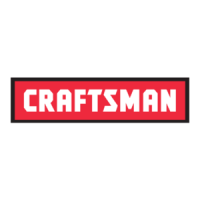
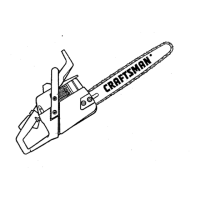
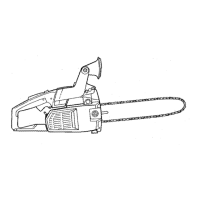

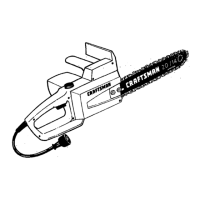
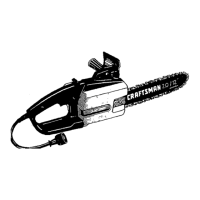
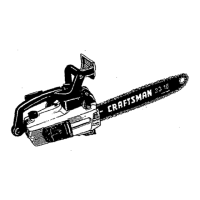




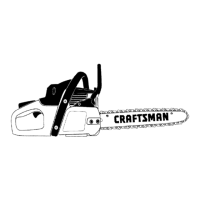
